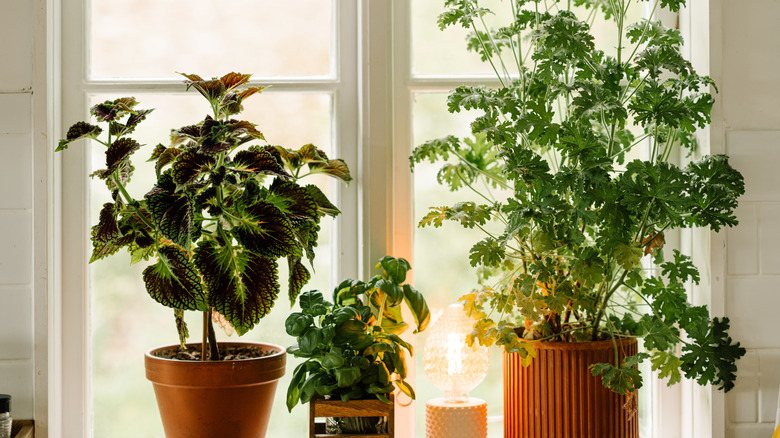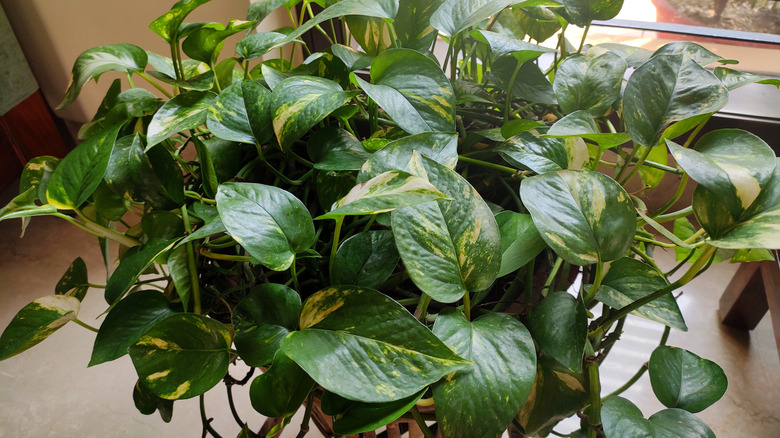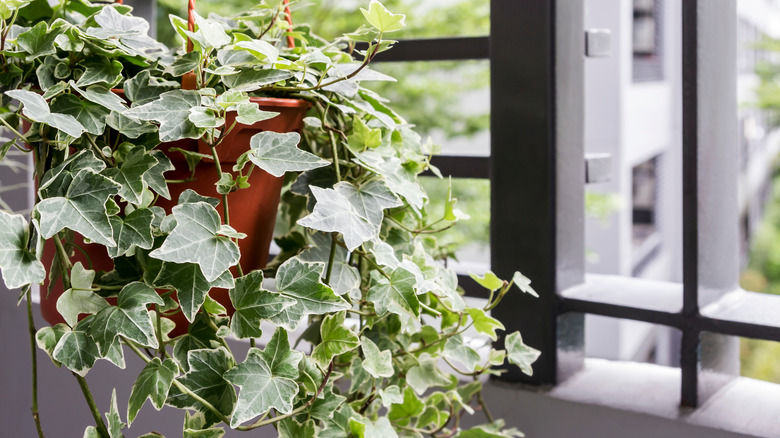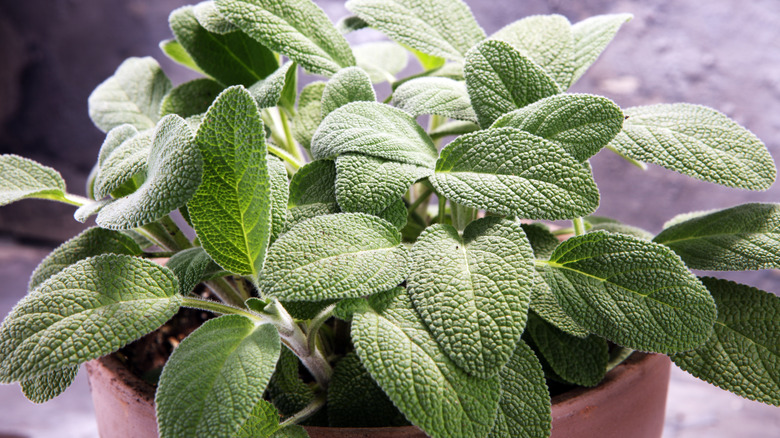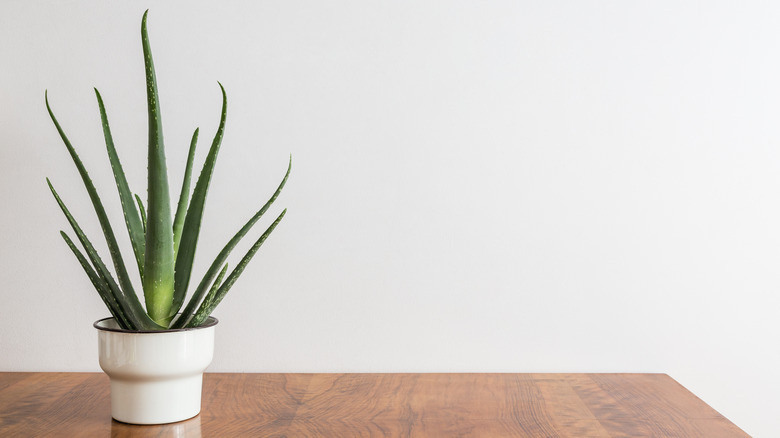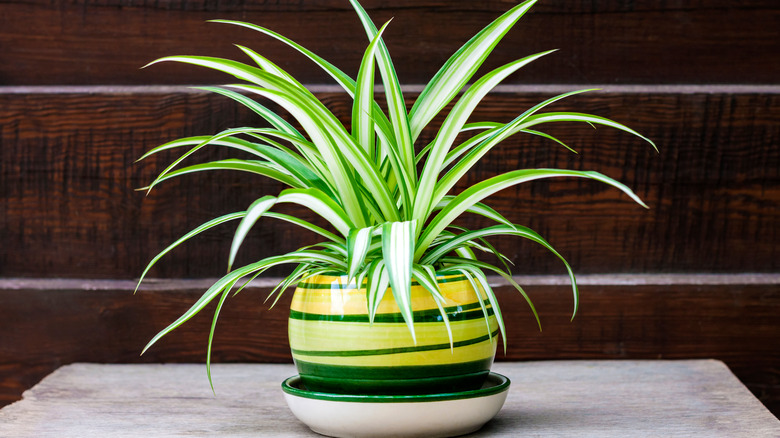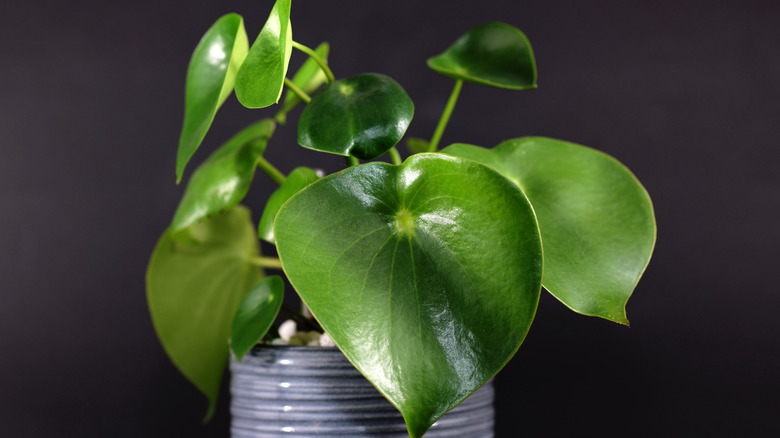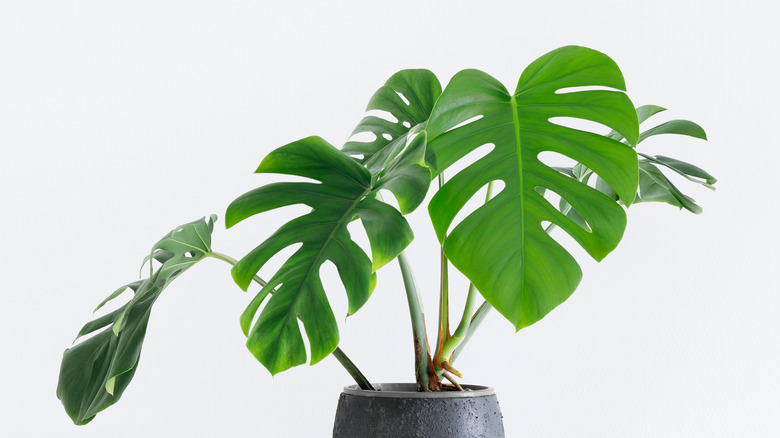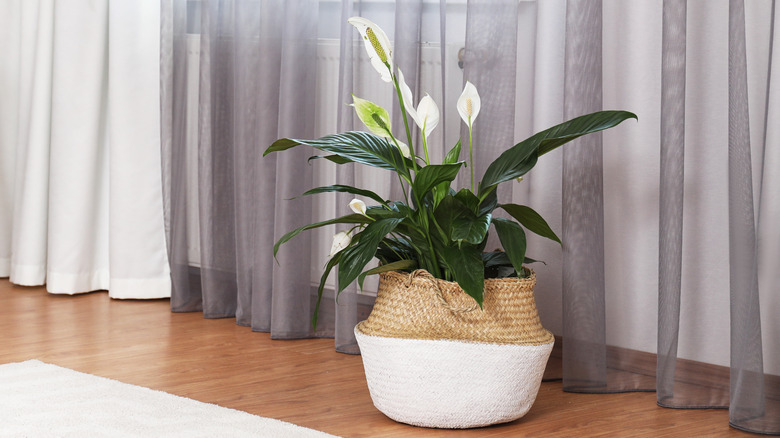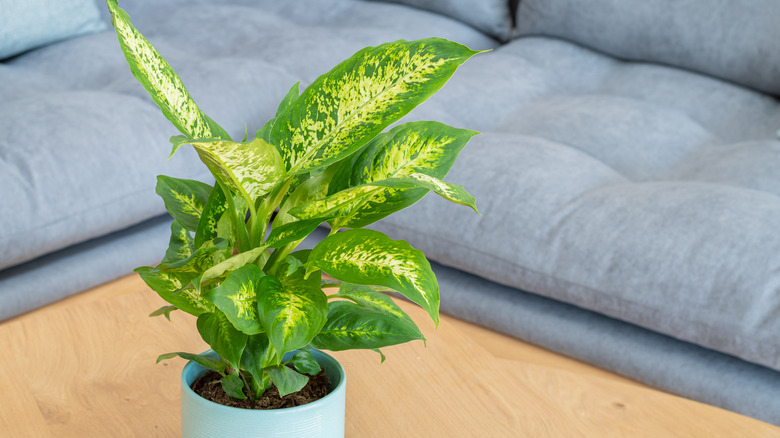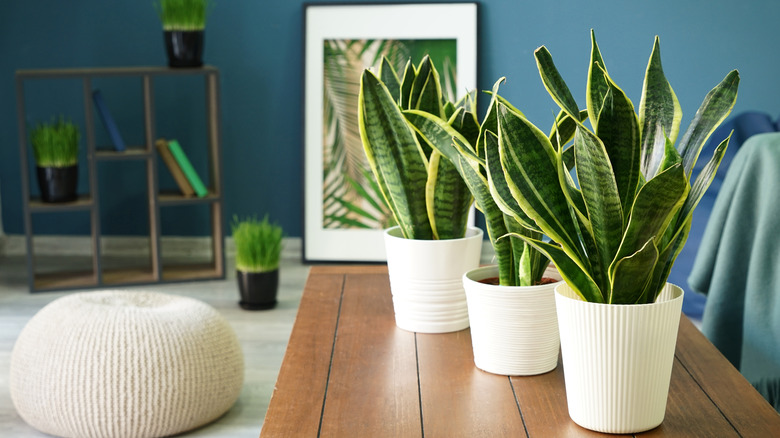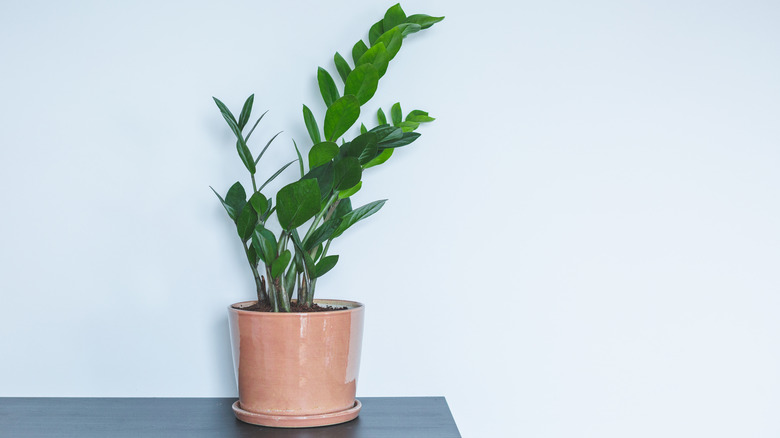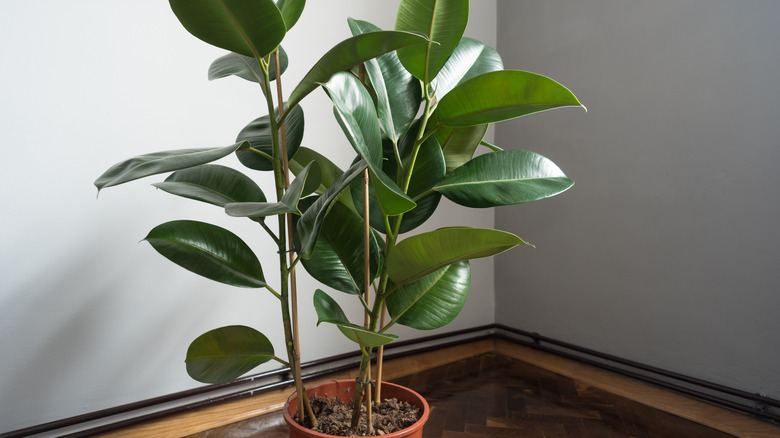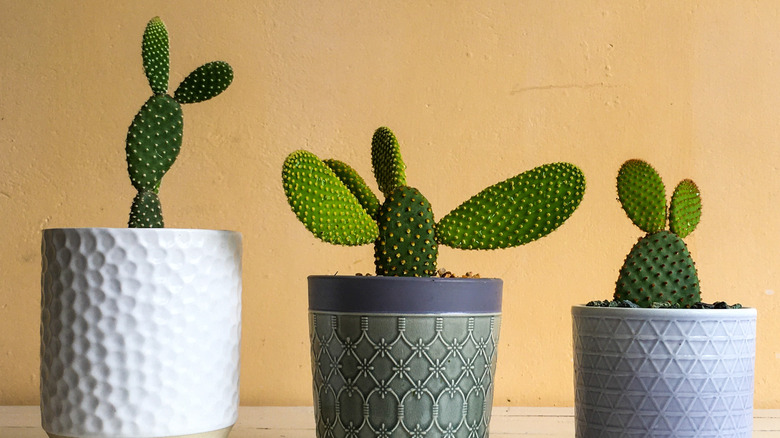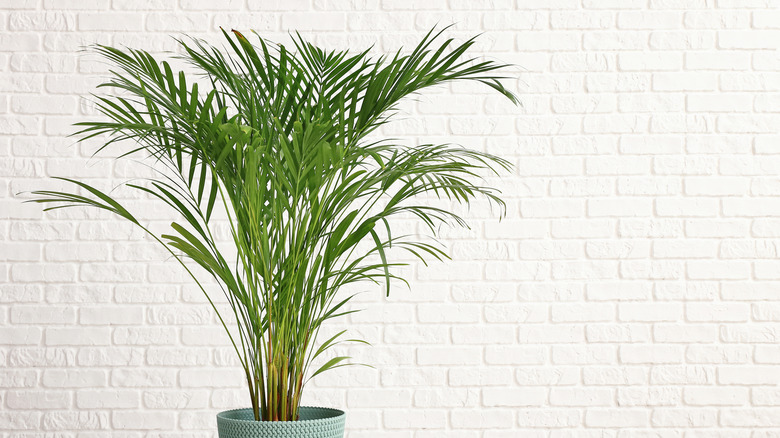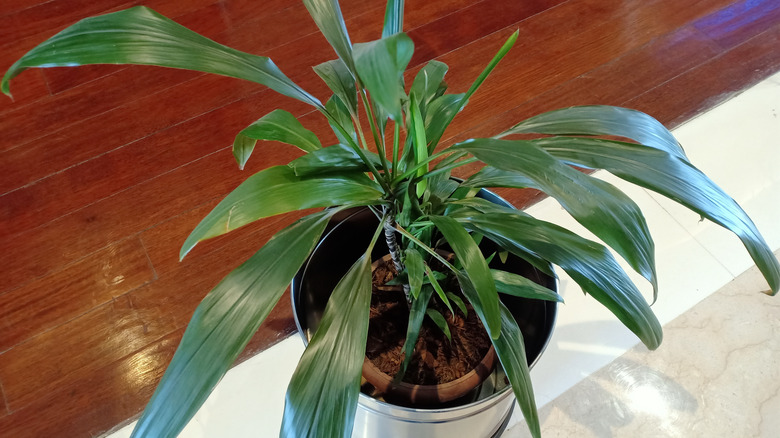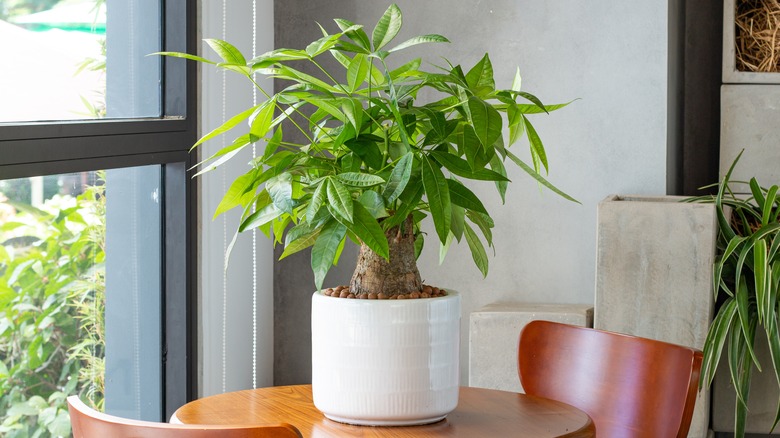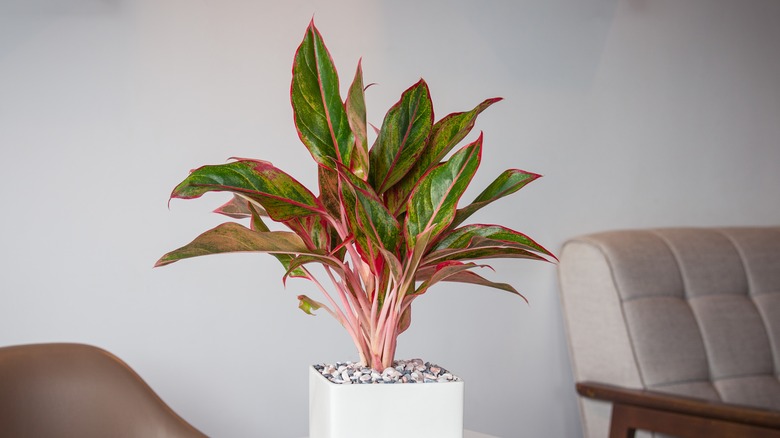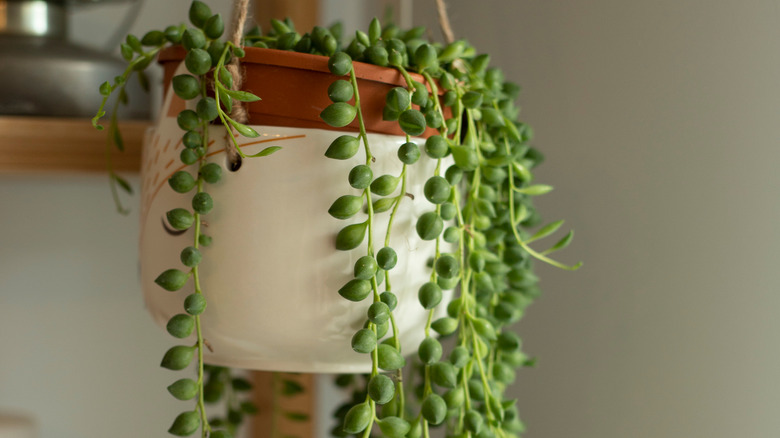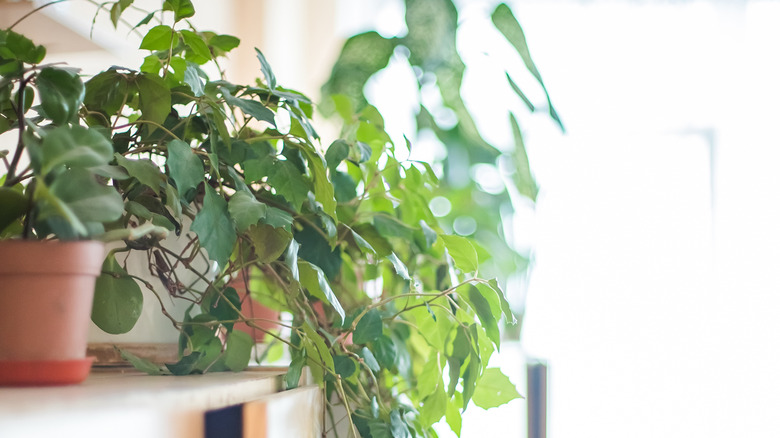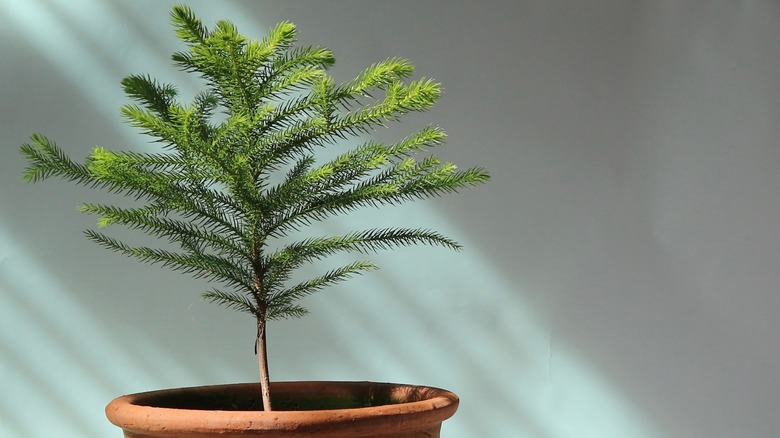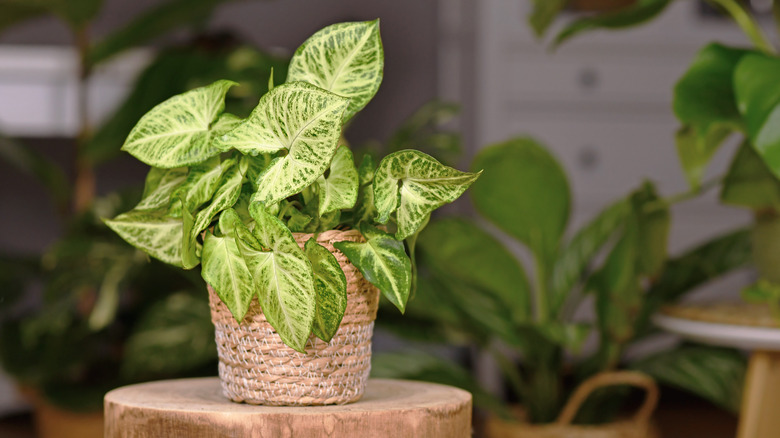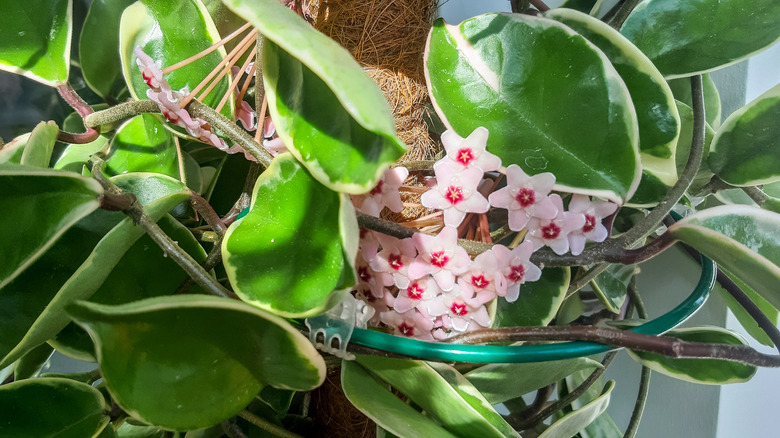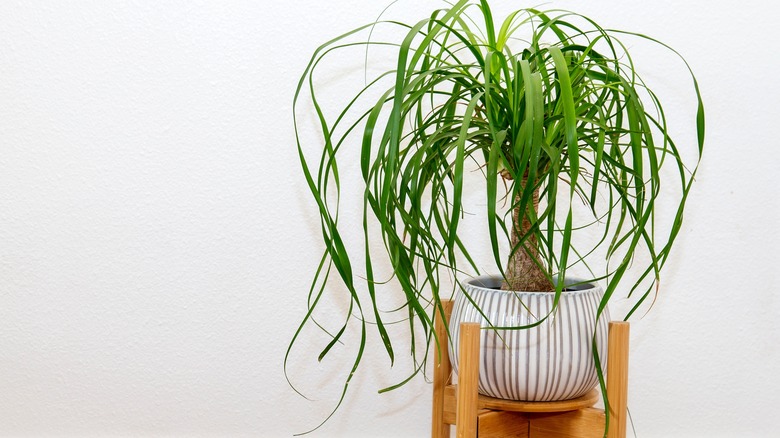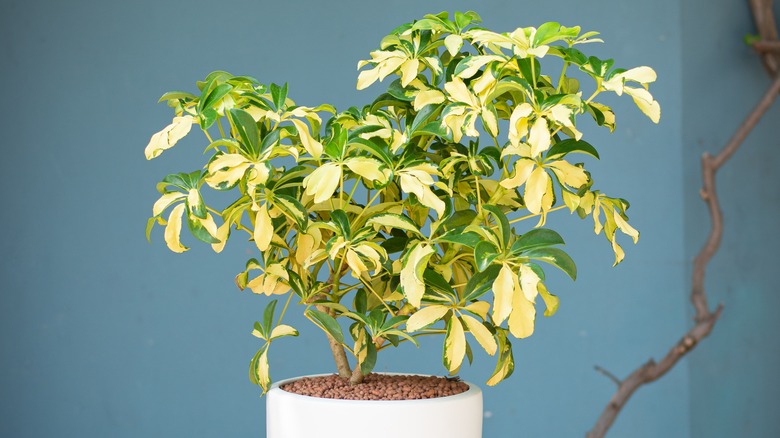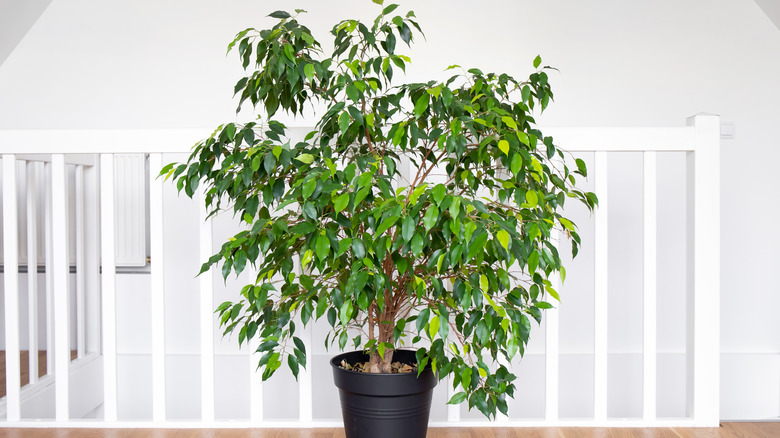25 Easiest Houseplants Anyone Can Keep Alive
The truth is that green thumbs aren't born; they're developed. While some people may have a natural ability to take care of plants, with the right information, anyone can learn how to take care of plants properly. The most common reason houseplants die is overwatering. Overwatering is often due to watering too frequently, essentially drowning your plant and or causing root rot. Watering too infrequently can also dry out your plant, making it shrivel up and die.
Another one of the keys to developing a green thumb is choosing the right kind of plant. Some plants, such as fiddle leaf figs, many calathea varieties, and tropical species, require care, attention, and maintenance, such as frequent watering and higher humidity levels. However, by choosing more easy-going plants — some that may even thrive when left alone — anyone can keep their leafy friends lush and green. Many of these easy-going houseplants require watering every seven to 10 days and just need to be placed in an area that provides the correct lighting. These easy houseplants are great for beginners and developing the green thumb you never thought you had.
2. Pothos ivy
Pothos plants (Epipremnum aureum) rank high on the list of the easiest plants to grow because they can survive serious negligence. These stout plants are not picky when it comes to light, and they can survive dry soil — up to a point. However, be careful not to overwater them, as that can cause the roots to rot. Let the plant tell you when it is thirsty. When leaves look wilted, give it a little water. As far as fertilizing, give pothos plants houseplant fertilizer every couple of months to keep them thriving. As an ivy, this plant likes to spread out along surfaces. In fact, if left on their own, pothos plants can grow anywhere from 12 to 18 inches a month!
Sunlight needs: Bright, indirect light
Water needs: Allow soil to dry out between waterings
3. English ivy
Another ivy plant that is known to be easy to care for is English ivy (Hedera helix). While they are easy to grow, English ivy plants need lots of light. However, don't put them in direct sunlight as that will burn their leaves. Ivy plants prefer humid conditions and do well in all-purpose potting soil. To keep these plants looking their best, fertilize them once a month, except during cold months. Keep your ivy plant in a pot that drains water well. English ivy vines will attach themselves to walls and other objects with tiny roots on their stems, so keep an eye on them.
Sunlight needs: Bright, indirect light
Water needs: Allow the top of the soil to dry out between waterings
4. Sage plant
Another plant that is easy to maintain is sage (salvia officinalis). Sage plants have small, fuzzy, pale green leaves. Sage does well indoors or outdoors, but wherever you keep your plant, it needs to be in well-drained or sandy soil. Sage can tolerate periods without water, and like most plants, when the leaves appear wilted, you know it is time to water it. Be careful not to overwater sage, as it can fall victim to mildew. As far as fertilizer goes, if you plan on using the leaves for spice, don't fertilize too much because the plant will not have as much flavor from growing quickly.
Sunlight needs: Place near a window where it will receive plenty of light
Water needs: Water when the soil is dry
5. Aloe vera
Aloe vera plants (Liliaceae) can handle it when you ignore them — for a little while, anyway. These hardy plants have thick, pale leaves with tiny teeth along the edges. Aloe plants are succulents and do not do well in direct sunlight because it can dry them out. The Old Farmer's Almanac recommends keeping aloe plants in terra cotta pots because they help the soil dry out between waterings. In addition, always keep your aloe in a pot that has drainage holes because too much water will cause it to develop root rot. When it comes to soil, the Farmer's Almanac does not recommend using regular gardening soil but instead, soil that drains well. Only fertilize about once a month during the spring and summer months.
Sunlight needs: Plenty of indirect light
Water needs: Water thoroughly, allowing the soil to dry out between waterings
6. Spider plant
Like aloe vera plants, spider plants (Chlorophytum comosum) can do well inside or outside. In addition, they can be pretty forgiving if you forget to tend to them for a couple of weeks. These plants feature long, slender leaves with white or cream-colored stripes. They also grow thin stems that feature small spiderettes, which make the plant ideal for hanging. While some houseplants might suffer when they are root-bound, spider plants actually seem to thrive that way. As a result, you should only repot them when the roots are visible or when the roots make it too difficult to water the plants. Spider plants like soil that drains well, and they do not seem to mind when the soil dries out between waterings.
Sunlight needs: Bright, indirect sunlight
Water needs: Water well, allowing the soil to dry out between waterings
7. Radiator plant
If you are looking for a small plant that is relatively easy to care for, then a radiator plant (Peperomia) might be just what you need. They get their name from the fact that they like it warm. The leaves of this plant can be heart-shaped, oval, or pointed. Some are a solid shade of green, while others are striped, marbled, or spotted. Some varieties also produce small berries and blooms. What makes radiator plants so great is that they can survive a few missed waterings and don't generally need fertilizer.
Sunlight needs: Medium to large amounts of sunlight
Water needs: Water occasionally, allowing the soil to dry out between waterings
8. Monstera plant
If you want to add a tropical atmosphere to your home, then you cannot go wrong with a Monstera plant (Monstera deliciosa). This plant features large, dark green leaves with long splits and holes in them. Like most of the plants in this list, Monstera plants need to be planted in well-draining soil in a pot that allows water to drain out. For the best results, as a bit of peat moss to the soil. Monstera plants also do better in humid environments. You do not need to fertilize Monsteras often, but you might need to prune them as they grow quickly. You only need to repot every couple of years and less than that if you don't want the plant to grow any bigger.
Sunlight needs: Bright, indirect light
Water needs: Water moderately when the top inch of soil is dry
9. Peace lily
If you have the space, you can't go wrong with peace lilies (Liliaceae). These tall, hardy plants, with their wide, glossy dark green leaves, add brightness to any room. Not only are peace lilies pretty to look at, but they are also known for cleaning the air. According to HGTV, they counteract toxic gases like formaldehyde and carbon dioxide. Peace lilies can grow in partial shade and even under fluorescent lighting, which makes them ideal for office spaces. They do not tolerate chilly air or drafts well, so put them in an area where the air is not blowing on them. If you use a fertilizer to help your plant bloom, it is best to go with an organic one as they tend to be sensitive to some chemicals found in certain fertilizers.
Sunlight needs: Moderate to low light
Water needs: Water thoroughly, allowing the soil to dry out between waterings
10. Dumb cane
Another large plant that is known for being easy to care for is the dumb cane plant (Dieffenbachia). The plant has large green leaves that look as though they have been splashed with cream or white paint. According to SF Gate, the dumb cane gets its name from the fact that if the sap is ingested, it can burn the insides of the mouth and even paralyze vocal cords. So if you have children and/or pets, put it in a safe place. Like peace lilies, dumb canes are known for purifying the air. For the best result, place them near a window. Fertilize every two weeks to once a month during the growing season with a liquid fertilizer.
Sunlight needs: Plenty of indirect sunlight
Water needs: Water until you see water draining from the drainage holes in the pot, and repeat when the top inch of soil is dry
11. Snake plant
With their tall, twisted leaves, snake plants (Sansevieria) add color and texture to any room. They are also surprisingly easy to care for — and there are around 70 varieties to choose from. Snake plants enjoy plenty of bright, indirect sunlight and humid conditions, so avoid placing them next to areas where they will feel a cold draft. While some plants enjoy a good misting, snake plant leaves are prone to develop fungal spots if they are misted, which will eventually kill them. Snake plants are also sensitive to overwatering. If the bottom of the stem becomes soggy, you know the plant is getting too much water. These plants do not need much fertilizer, but you will need to replace the soil about once a year to prevent root rot.
Sunlight needs: Bright, indirect sunlight
Water needs: Allow the soil become completely dry between waterings
12. ZZ plant
The ZZ plant (Zamioculcas zamiifolia) is another plant that is well-known for being resilient to neglect. These tropical plants have small, shiny leaves that can grow up to 6 inches long. These plants aren't finicky when it comes to light, but they will grow quicker if they receive an adequate amount of it. They do best in soil that drains well, and they need to be planted in a pot that has drainage holes in the bottom. A basic potting soil mix with ¼ compost and ¼ sand added is enough for ZZ plants. While they can even do well without fertilizer, using an all-purpose fertilizer every so often cannot hurt.
Sunlight needs: Tolerates varying amounts of light as long as it is not direct
Water needs: Water every two to three weeks when the top 3 inches of the soil are dry
13. Rubber plant
Known for their large, thick leaves, rubber plants (Ficus elastica) are fairly easy to care for. That being said, you won't be able to neglect them for weeks at a time. If you give rubber plants the amount of water, nutrition, and light they need, they will thrive. The one thing you may need to be cautious about is overwatering, which can lead to root rot. You will need to fertilize your rubber plant every two weeks with a water-soluble fertilizer during warm months. While rubber plants are ideal houseplants, they are toxic to cats and dogs. Additionally, the sap from them can cause allergic reactions in some people, so keep them in safe areas of your home.
Sunlight needs: Plenty of indirect light
Water needs: Keep the soil moist
14. Prickly pear cactus
If you want a small plant that does not require too much attention, then a prickly pear cactus (Opuntia) might be just what you need. Of the dozens of varieties of cacti, these might just be the easiest to keep in your home. The soil is perhaps the most important factor in the life of your cactus. Use a mixture that is more rocks and sand to ensure that the soil drains properly. You should also use fertilizers for cacti and follow any instructions. If your cactus plant begins to show yellow spots, that means it is getting too much sun. Too much water causes the roots to rot, so plan on checking the soil every 10 to 14 days.
Sunlight needs: Plenty of direct sunlight
Water needs: Water when the top 2 to 3 inches of the solid is dry
15. Palm plant
Along with ZZ and Monstera plants, palm plants (Arecaceae) give your décor a tropical vibe. These plants like a lot of humidity, but most types can adapt to drier environments. That being said, if you keep a palm in an area with low humidity, give the fronds a mist from time to time to keep them looking their best, explains Bloomscape. You should fertilize them about once a month with houseplant fertilizer. Bloomscape recommends diluting fertilizer for hapis, bamboo, Chinese fan, and cat palm plants. Most palm plants thrive in temperatures between 60 and 80 degrees Fahrenheit, and most will not tolerate temperatures below 55 degrees. Most palm plants are not toxic, but the fruit of the fishtail palm is considered toxic.
Sunlight needs: Most palms do well in areas with plenty of direct sunlight
Water needs: Water when the top half of the soil is dry
16. Cast iron plant
Known for tolerating light and temperature extremes, the cast iron plant (Aspidistra elatior) is a fantastic option for people who have trouble keeping plants alive. These plants have thick leaves and can grow up to 2 feet tall. Part of what makes these plants ideal for indoors is that they can tolerate low lighting and soil that gets too wet or too dry on occasion. Like palm plants, the cast iron plant is a slow grower and does not need heavy fertilization. If you keep the plant in a well-lit area, fertilize with a diluted liquid fertilizer about once per month, as noted by Plant Care Today.
Sunlight needs: Place these plants next to a north-facing window where they will get plenty of bright light
Water needs: Keep the soil moist but not constantly wet
17. Money tree
Known for bringing good luck and prosperity, a money tree (Pachira aquatica) has been a favorite housewarming or new job gift. Plant lovers tend to love the unique braided trunk and dark green leaves, but it's the easy care that makes it a stunning option for your house plant collection. The tree can grow up to 8 feet indoors, so it can also be a centerpiece of a room, and you don't need the greenest thumb to get this plant to grow or maintain its impressive height.
Sunlight Needs: Bright, indirect sunlight for at least six hours
Water Needs: Only water when the soil is dry
18. Chinese evergreen
Chinese evergreens (Aglaonemas) are a genus of flowering plants with some of the most unique leaves. These plants can have variegated shades of green, pink striping, and even polka dots. A bonus of these plants that look like they're hand-painted is that they're relatively tolerant and trouble-free, making them a great option for beginners. These plants adapt well to their surroundings, are durable, and can grow up to 3 feet tall. However, be cautious, as Chinese evergreen can be toxic to people and pets if chewed, swallowed, or ingested.
Sunlight Needs: Low to bright indirect light
Water Needs: Every five to 10 days, but don't let the soil get soggy
19. String of pearls
As a succulent vine, string of pearls (Senecio rowleyanus) make great plants for beginners or forgetful plant parents. The leaves evolved to be little balls that grow on a vine, and many people prefer to hang this plant. As long as the spot you put it in receives a good amount of sunlight, you can leave this plant to let it thrive. As with most succulents, it prefers to be left alone and doesn't need you to fuss over it daily.
Sunlight Needs: Bright, indirect light
Water Needs: Every two to three weeks
20. Grape ivy
Ivy is known for being an easy-going plant, and grape ivy (Cissus rhombifolia) is no exception. With over 350 varieties of grape ivy, you're sure to find the perfect one for your space. Oakleaf ivy is a popular variety because the deep cuts make for interesting leaf shapes. You can use a trellis to allow the ivy to climb or place it in a hanging basket, allowing it to cascade over. Under the right care conditions, a grape ivy can grow to an impressive 6-foot vine.
Sunlight Needs: Partial shade to low light
Water Needs: Water when soil is dry to the touch, about weekly
21. Norfolk Island pine
Bring the beauty of an evergreen tree indoors with a Norfolk Island pine (araucaria heterophylla). While these trees can grow outside, they can also thrive as houseplants and grow to an impressive 10 feet under the right conditions. Norfolk Island pines can bring stunning texture as well as the cozy feeling of being in the woods. A bonus is that you can decorate it for the holidays, which can be a great space solution for smaller homes and apartments.
Sunlight Needs: Bright, indirect light
Water Needs: The surface of the soil should dry in between waterings
22. Arrowhead vine
Arrowhead vines (Syngonium podophyllum) are the plants to go with if you're looking for an interesting leaf shape. The triangular leaves are reminiscent of an arrowhead, and with silvery-green, pink, and bronze tones, these are beautiful houseplants to add to your collection. Because they're vines, they can grow upwards on a support or trellis or can be allowed to trail in a hanging basket. Be cautious, as every part of the plant can cause irritation if ingested.
Sunlight Needs: Medium to bright indirect light, direct sun can burn the leaves
Water Needs: Once a week in spring during active growth and every 10 to 14 days when inactive in the fall and winter
23. Hoyas
Often called waxplants, hoyas are stunning tropical plants known for their distinctive thick leaves. Most varieties of hoyas are vines, but others can grow in a bush-like shape. Popular hoya varieties include hoya carnosa and hoya kerrii, which have heart-shaped leaves. This species is also loved for its variegated versions, which makes the unique leaves even more striking. Plus, when grown in the right conditions, some hoy varieties sprout five-pointed star-shaped flowers.
Sunlight Needs: Bright, indirect light.
Water Needs: Once a week, but ensure the top inch of soil is dry
24. Ponytail palm
Though it may look like a palm tree, ponytail palms (Beaucarnea recurvata) are not related to true palms. The palm-like appearance is thanks to the thick trunk and the long arching leaves, which can add a tropical feeling to the space. But unlike other tropical plants that often require a lot of maintenance, ponytail palms are relatively easygoing. The trunk store water, so it won't need a ton of water, which can be ideal if you're a beginner or a hands-off plant lover.
Sunlight Needs: Bright light
Water Needs: Once every two weeks, the soil should dry out between waterings
25. Umbrella tree
Another favorite houseplant for its stunning leaves and easy care is the umbrella tree (Schefflera actinophylla). This plant features seven glossy leaves that grow out from a central point, creating an umbrella-like shape. There is also a dwarf variety (Schefflera arboricola) and variegated varieties, so you're sure to find the perfect umbrella tree for your home. Growing up to 8 feet tall, this plant can be a stunning indoor plant option.
Sunlight Needs: Medium to bright light
Water Needs: Water about once every 10 days; the top half of the soil should dry out.
26. Weeping fig
Many ficus plants seem to become the it-plants, but unlike relatives like the fiddle leaf fig, which can be pretty fussy, the weeping fig (Ficus benjamina) is much more easy-going. The slim teardrop-shaped leaves and sleek branches also make this a much-loved houseplant of interior designers. They can grow up to 15 feet tall, so they can also make a great natural statement.
Sunlight Needs: Bright, indirect light
Water Needs: Water about once a week, allowing the soil to dry in between
